"...But what of the wife! God have mercy on her! The horse fell down in a fit of temper! And the count, to ease her sigh, Tears the cloth from her shoulder, And the gown from her shoulders crawls, And on her shoulder burns the mark! The executioner was a master, and there's a lily in bloom..."

Today it is unusually fashionable to wear tattoos on the body as a sign of self-expression, a rebellion against the system, to hide skin flaws. Branding or applying a tattoo to the human body has been known since the ancient world, when masters branded their slaves. And in the Middle Ages it was used to "mark" convicts working in the galleys, who could be recognized in the "crowd" if they escaped. In World War I they branded deserters, during the Civil War - the Whites branded Communists, during World War II - the Gestapo stamped individual numbers on the bodies of concentration camp prisoners.
WHAT DOES THE LILY ON MY LADY'S SHOULDER MEAN?
Why a lily? Or maybe Milady is not so guilty - if you think about it, maybe she is not the main villain, but actually the Musketeers, the four men who destroyed one woman in an unequal confrontation? Recently we were re-watching our Soviet film, and for the first time I wondered about this question. And after my husband said that before, a woman just had to know her place - my eyes were opened. And even the lines from the heroine's monologue confirm this, "The world of proud women is surrounded by an unconscionable game. For throwing off the yoke There's a brand imprinted on her shoulder."
A noble flower
A tattoo of a lily is not just a drawing. Such an image can even be found on icons of the Annunciation. For example, in the hands of the Archangel Gabriel. This flower symbolizes the Virgin Mary herself. That is why it is honored by every believer.
In Egypt, these flowers decorated the bodies of young dead girls. People believed that in the other world they would have many children. Also, the lily indicated, again, their innocence and purity.
Well, if you believe the German medieval legends, the lilies are inhabited by elves - fabulous good creatures.
HERALDIC LILY SYMBOL
I'll start right off with the point. Why is there a lily on the branding? The lily is the symbol of the royal family of France. It is the most common symbol in heraldry after the cross, the eagle and the lion. Quite logically, criminals were branded with such a sign - as a sign of royal justice. On the other hand, the lily is also a symbol of purity, innocence, the Virgin Mary and Christianity in general. Isn't that a lot of honor for vagrants, thieves, and prostitutes?
Interesting but true - the flower is called a lily, but in fact, instead of it everywhere is depicted iris. And it is the wild yellow marsh iris. If you look closely, the iris resembles a woman's genitals. When Athos in the movie draws the flower on the wall, you can see that it is much more elongated than the real one. There is an interesting theory that it is an allusion to the fallopian tubes, which were necessarily to be tied by medieval prostitutes as a means of contraception. The anger of Athos - then still Count de la Fère - may have been caused not by the fact that the girl turned out to be a thief, as Dumas delicately presented it, but by worse suspicions. But all the same, his act is little understood - so loved, and almost anything, killed without even looking into it. But more about that below.
The lily is the emblem of the royal court
Those who have read Alexandre Dumas' famous novel The Three Musketeers will remember that the infamous mark was on Milady's body, viz. the brand of a lily on her shoulder. In France This flower had a special meaning. The fact is that King of the Franks Clovis I Merovingian (reigned 481 - 511) became a Christian, and according to legend, an angel gave him a golden lily. This flower "...is especially revered as a sign of good hope and blameless living...and those who use lilies in their coats of arms have been good, fair and honest...".
In the Middle Ages, the lily became an emblem of France and royalty. King Louis VII (reigned 1137 - 1180) wore a shield with an image of this flower. The Fleur de Lys was the name of the yellow lily which was depicted on the coat of arms of France under the Capetins and Bourbons. When the legendary Joan of Arc was about to save her native Orleans from its enemies and met the as yet uncrowned Charles VII, she was given a standard with golden lilies as a symbol of the king's power. The noble plant was present on the coats of arms of such cities as Wiesbaden, Daugavpils, Detroit, New Orleans, Florence, and Turku.
LADY WINTER.
Little is known about Milady's background and life before the novel begins. In a conversation with Rochefort, she reveals that she was born in Armantiere, a small town near the convent of Bethune. At the same time, Dumas says that she knew perfectly well the customs and peculiarities of the English Puritan faith - she was taught this as a child by an old servant. Why would a Frenchwoman have an Englishman in her service? Although this is not the most controversial point - in Ann and Serge Golon's novel, Angelique's servant was a former German soldier, Guillaume Lutzen. Milady's impeccable English pronunciation is also noted. Not to mention her nickname. Her middle name, Lady Winter, is also English, after her second English husband. Most likely Milady's father is English and her mother is French. According to the context of the book, Milady is an English spy in the service of Richelieu, recruited shortly before the beginning of the novel. The heroine's real name, as well as her origins, are not clear. Only near the end does Athos list her names. But again there is no accuracy - some researchers write that her real name is Anne de Beillet, others - Charlotte Baxson. That is, once again the origin is not clear: if the first name is true, then Milady comes from France, if the second, then she is English. In the film, Milady asks the Cardinal for a hereditary title as a reward for her service. Here again there are several options. Either she does not have the title or she has lost the right to it, or she is English and she needs the title in France. The latter is more likely - as by her second husband she had the title of Lady Winter secured to her son.
General Significance.
Next point. The "lily" tattoo has a far from simple meaning. But first of all, the flower speaks of tranquility, harmony, naivety and submissiveness. However, the meaning also varies depending on the color.
The yellow lily, on the other hand, speaks of rebelliousness and haughtiness. Pink suggests tenderness and youthfulness. Tiger or orange denotes independence, intransigence and even hatred.
Thus, having met a person with such a tattoo, pay attention to its color. It can tell a lot.
ATOS AND MILEDY
What kind of love is it when you are absolutely ruthless to the person you love? Athos was not embarrassed by Milady's origins, nor by the fact that she was not a virgin, he even "went against the will of his entire family." And the stigma could not survive. And anyway, how is it to take his own wife and hang her in the middle of a hunt like in some wild times! About this contradiction and the whole novel Dumas. Cardinal Richelieu in it is the main villain, the antagonist, and the Musketeers are the positive heroes. In reality, it was the opposite. Athos is a member of the old aristocracy, apparently from a very ancient and noble family. He mentions once in a conversation with d'Artagnan that his mother was a lady of state of Queen Maria de' Medici, that is, the first lady of the court. It is a very high position. Athos says of himself "as noble as Dandolo and Montmorency. The Montmorenci are an ancient noble family, princes of blood who were related to the royal family. Under the "old order" nobles had the authority of full rulers in their lands. They had the right to mint their own coinage, had their own army, and the king did not always have complete power over them. But over their subjects he had none. Remember the saying "my vassal's vassal is not my vassal. That is to say, Athos was perfectly within his rights to do what he wanted in his own land. His real name was Count de la Fère. The French word for "fer" is iron. The iron count. Cruel-hearted, impassioned, eager to control his passions. Once he let his guard down, he's been trying to get back at it ever since. He is ruthless and hard as an iron blade against everything and everyone. His three friends, of considerably lower birth than he, are the only exception in Athos' cold soul. By the way, the exception is not in everything. In the novel Twenty Years Later, Athos, who has regained his title, cannot introduce d'Artagnan to his guests under his mere title-he calls him "Chevalier d'Artagnan," that is, he raises him to a level acceptable to his entourage.
Features of tattoos for women and men
The image of the lily on the male body, can not be called a rarity. True, the flower in this case serves not as a separate image, but as a detail of the composition. Often it is combined with a sword or dagger. Such a picture means strength of character and the ability to keep his word.
In its pure form, the tattoo is considered to be female. However, not all ladies put into it the standard meaning. Often the drawing is considered a symbol of ...of tenderness and beauty.... With its help girls want to emphasize their own femininity and sense of taste. Such tattoos can advantageously highlight the curves of the body, give the figure softness and sexuality.
THE HEROES OF THE NOVEL "THE THREE MUSKETEERS".
It seems that the heroes of the famous novel are not quite what we are used to perceive them to be. D'Artagnan is not the main character, but only a cover for deeper content. The essence is in two points:
1)The confrontation of the archetypal masculine (Athos) with the older archetypal feminine (Milady). The patriarchy and chauvinism, which subjugated women with brute force, were periodically powerless against female sexuality. Unable to restrain themselves and failing to achieve reciprocity, all men could do was destroy the object of lust. This is what Athos does to his wife.
2) The confrontation of the nobility with Cardinal Richelieu. Richelieu is a villain for this reason - the purpose of his whole policy was to fight the feudal liberty (which Athos, being a count, used to his utmost) and to strengthen the vertical of power. He banned duels, which immediately reduced the number of deaths among young nobles. He ordered to tear down the feudal castles and build open palaces in their place - so that the nobles would not try to hide behind impregnable walls from the royal will. He appointed royal intendants to the estates of the aristocracy - to have control. Athos and Richelieu are mortal ideological enemies.
Milady is twice the enemy to Athos. Both as the woman who defiled his kind and as the Cardinal's henchwoman.
That said, the rest of the Musketeers feud with Richelieu rather "for company." D'Artagnan's father, on the contrary, instructed him to show respect and serve the three men - the King, the Cardinal, and Monsieur de Treville. Because he is a petty nobleman, Richelieu's politics did him no such damage. In the film, after a game of chess in the Cardinal's palace, d'Artagnan tells Richelieu that yesterday he might have considered serving with him, but today his friends are among the King's musketeers. Clearly their enmity was not original. With Aramis it is more complicated - his personality is the most mysterious of all. In the book, his servant Bazen says that "Aramis" is the opposite of "Simara," the name of one of the demons. The word "Simara" has another quite innocent meaning, that of a priest's cassock. Given that Aramis is an abbot rastrigan, always dreaming of returning to the priesthood, it is not surprising that he chose such a nickname. All three musketeers have names that hide their dark past. With Athos it is clear - a fugitive disgraced count. Aramis is a man forced to leave his ministry in order to learn how to sword and avenge his abuser. Richelieu is more of an enemy to Aramis because of the circumstances - he has forbidden duels, and Aramis just had to make a "date" with the nobleman who insulted him. With Porthos it is not yet very clear. He's only in Twenty Years Later trying to get at least a baronial title. So Richelieu was hardly his real enemy - his reforms had little to do with Porthos.
The Musketeer friends are brought out as positive characters, though their behavior is far from flawless. Athos is a drunkard and a murderer. Porthos openly courts a married woman for money, while showing up at her house, presenting himself to the husband as his wife's cousin and spending his own money. Aramis in the first book is not particularly guilty, but then made up for it. In "Twenty Years Later," he is the lover of Madame de Longueville, an active participant in the Fronde - a noble conspiracy against the King. In "Ten Years Later," he becomes a Jesuit who betrays his friends. D'Artagnan changes women like gloves. First he loves Constance, after her abduction he has an affair with Milady and at the same time with her maid Kathie - using her, knowing that the girl is in love with him - to break into her mistress' chambers. To Milady herself, in order to spend the night with her, he presents himself as the Count de Varde, with whom she has been in love. In order not to be unmasked, he hides his face in the dark. And at the end, this magnificent foursome, bringing with them four servants, an executioner, and Lord Winter, gathers to kill one woman in an unequal fight.
Places to apply
The lily tattoo is harmonious and appropriate on any part of the body. In most cases, they have a composition of a triangular shape. Most often depict a flower on the forearm or hand.


Such a tattoo looks natural. The lily on the waist looks coquettish and emphasizes the curves of the waist. Applying a tattoo on the belly excites the imagination, gives sexuality.
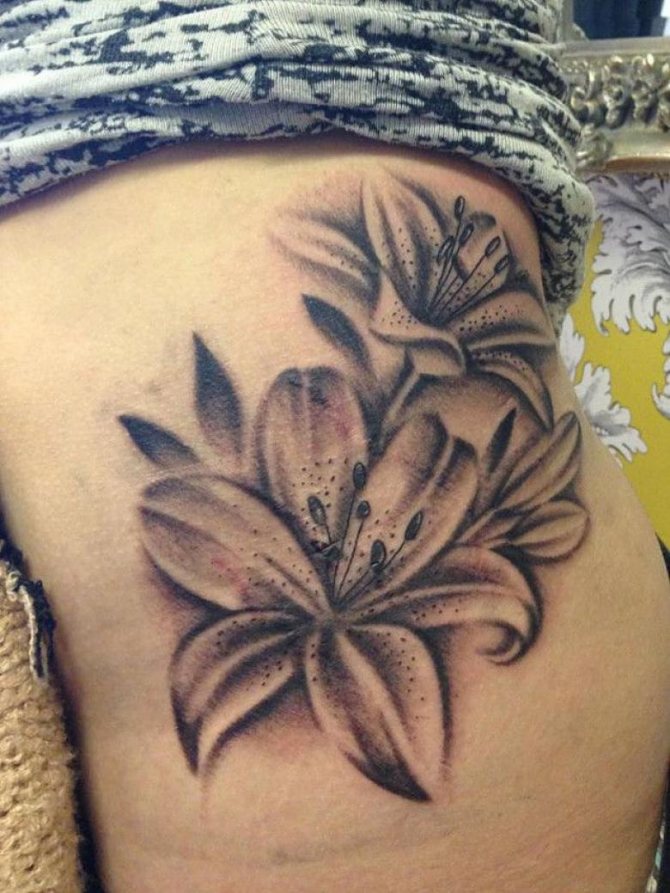

A tattoo as a garter of lilies around the hip looks erotic and feminine.
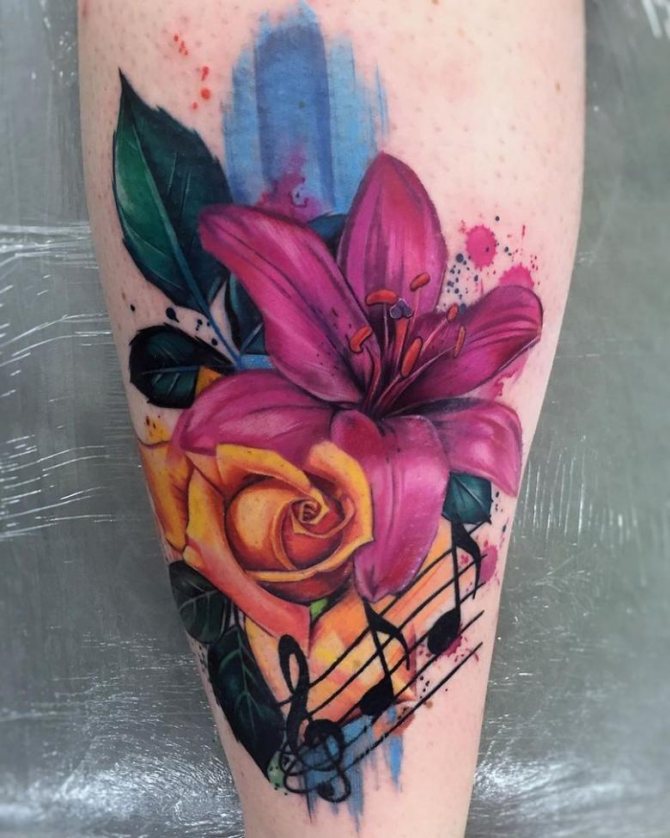

The image of one or more flowers on the back, spine do bold girls with a commanding character. Lilies on the side look graceful.
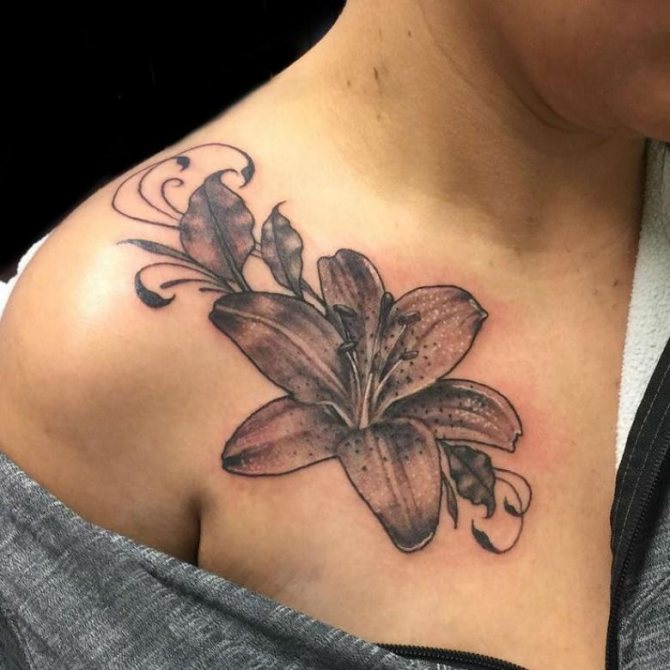

This part of the body is used by both sexes. Women - to reflect self-confidence, and men - to attract attention to their person.


THE BRANDING ON THE SHOULDER OF A MILADY
As a representative of a small noble family, Milady was expected only two ways - either to marry a humble man or a convent. She ended up in the latter. She spent two years there and escaped with a young monk whom she seduced. Before escaping, he stole church property. The fugitives were found and the monk was sentenced to imprisonment and branding. The executioner was his brother, who, in a fit of desperation, branded the girl as well.
The first fact - there was no justice, it was arbitrary on the part of the executioner.
The second fact is that if Milady was 16 years old at the time of her marriage, it means that she was 14-15 years old when she escaped from the convent. There is some doubt as to who else seduced whom.
The third fact is, what evil deeds did Milady actually commit, besides the murder of Constance? The seduction of the monk - there are a lot of questions about that. The murder of Buckingham? So it was part of her work for the Cardinal, and she did not kill him, but the fanatic Felton. Corrupted and ruined that poor Felton - so he was a puritan who could barely stand Buckingham as it was. The murder of her second husband, Lord Winter - here there is nuance.
Milady's first marriage ended in a nightmare. The legitimate question is how did the husband not see the brand on his wife's shoulder? But it's quite understandable - in the past it was considered immodest to undress completely. Obviously, no one peeped into the bedroom, but Athos could well understand his wife's embarrassment and did not insist. Having married for the second time, Milady, apparently, decided not to wait any longer for her husband's reaction and poisoned him immediately after she became pregnant. She needed her son to be her heir and she, as his mother, held the title by right.
Variations of placement on the body
The location of the tattoo on the arm is considered a classic. For example, in the area of the hand, wrist or forearm. The flower in this case looks natural and harmonious. Give the tattoo sexual connotations will succeed if the small lily will be placed in the loins. It looks very playful and is able to emphasize the beauty of the female figure.
A similar effect can be achieved if the pattern is printed on the abdomen. It gives a special grace and excites the imagination. For brave, decisive ladies, a tattoo in the area of the back is suitable. You can even place several colors here at once. For example, along the spine or diagonally.
A medium-sized tattoo looks great in the shoulder blade area. Miniature variants are printed in the area of the neck and wrist. Among the more savory variations is the lily tattoo, located on the side. It will be an excellent solution for self-confident, sexy ladies. On the male body, such a tattoo will also look original.
Tell your friends:
THE MILEDEE'S KITCHEN
Athos describes Milady as "a girl of sixteen, as lovely as love itself. Through the inherent naivety of her age shone through a bubbly mind, a poet, a woman's mind. She did not just like - it intoxicated. In the film he says, "There are no such refined manners in all Provence. From other descriptions of Milady, we learn that she: speaks several languages perfectly, knows many nuances of completely different aspects of life, can find a way out quickly in any situation, knows how to handle weapons, has great physical strength and a "wonderful voice. As a real archetypical woman, she has a lot of masculine traits. Female weakness is alien to her, though she knows how to play it off and use it. No man has ever been able to control her, so all they could do was destroy her physically. Think about it - five men (including the executioner) against one woman! And in the book there are ten - there were also the Musketeers' servants and Milady's brother-in-law Lord Winter. And barely, barely they were all able to fight her. Dumas writes how Athos ordered a change in the servants guarding Milady only on the basis that she said something to them.
"The Three Musketeers" is a novel about men, and the main characters are men. It wouldn't be until 100 years later that authors would make women heroines. In the book, however, there are only three women - Constance, the Queen and Milady - for a huge number of men. In the novel about Angélique, the Marquis Plessis-Bellières, recalling the reign of Louis XIII, says that it was a time of rude warriors who lived by war and duels. There was no place for women - even very strong ones - back then.
Tattoo styles
Applying a colored or monochrome tattoo depends on individual preference. Warm tones and smooth lines are suitable for young girls with a calm character.


Rich colors and clear outlines are characteristic of the owners of the ardent temperament and strong character. Based on the ambiguity of the meaning of the tattoo must be carefully and carefully select the sketch and color composition to affect its interpretation.


The effect of the tattoo on character
The owner of the tattoo with a lily acquires poise and peace of mind. The flower, depicted in dark colors, gives courage and boldness to a humble nature. Tattoo heraldic lily gives fearlessness and nobility.
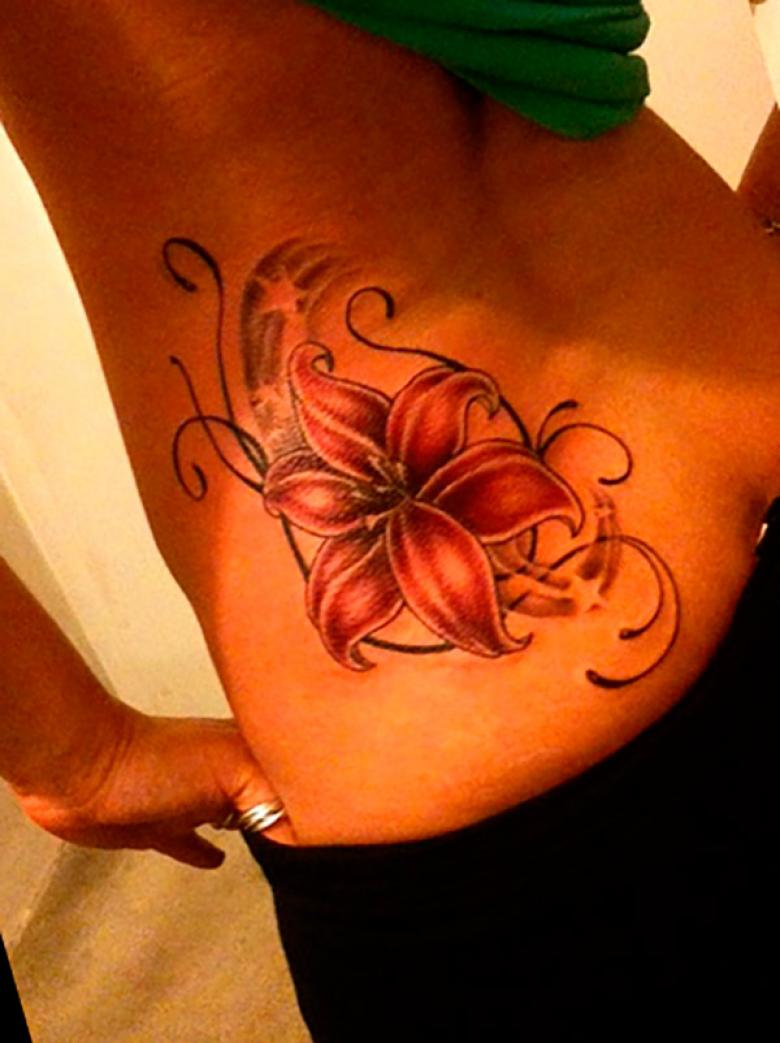

Naturals with a violent temperament endows balance and harmony of body and soul. Royal lily adds confidence in decision-making and self-confidence.
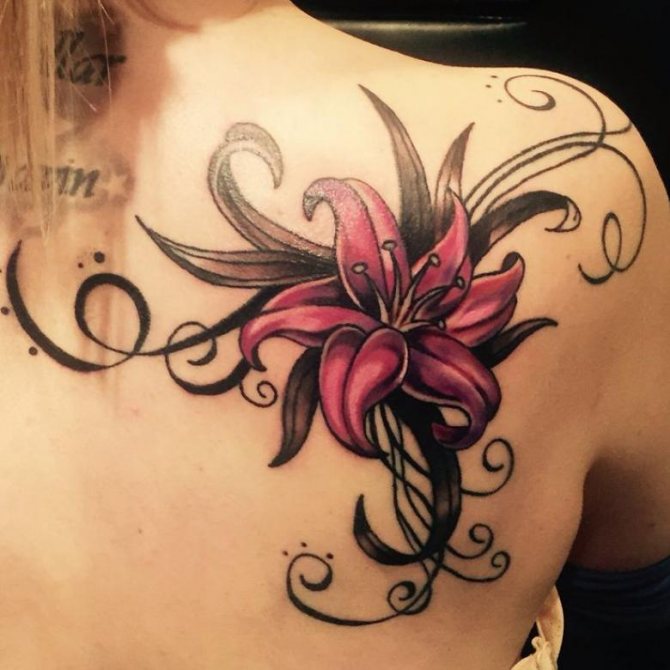

In the pursuit of beauty should not neglect safety. For the tattoo you should apply in a specialized tattoo parlor.
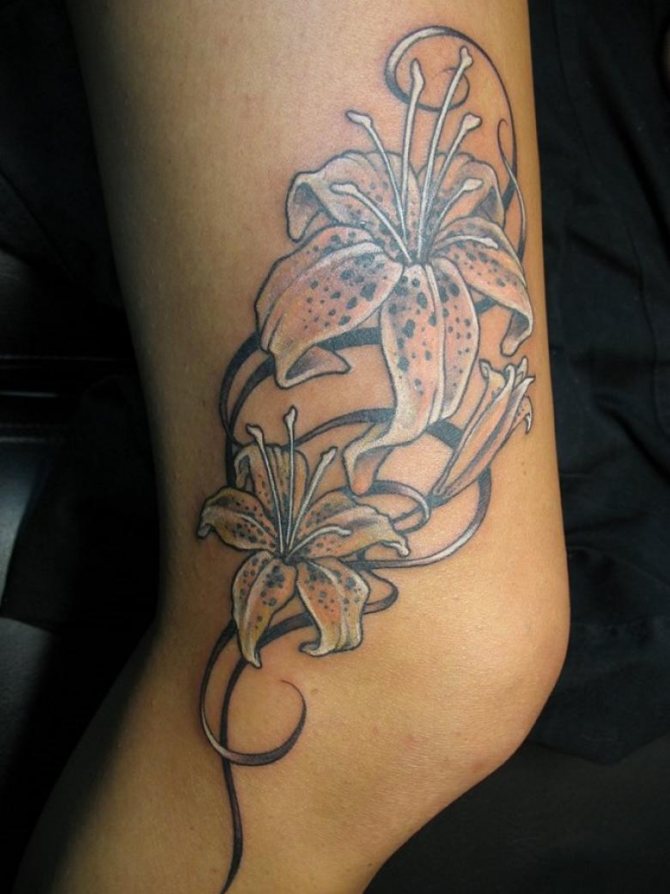

Qualified masters will help you decide on the idea of the composition, provide a catalog of good works that will facilitate the choice of a future tattoo pattern.
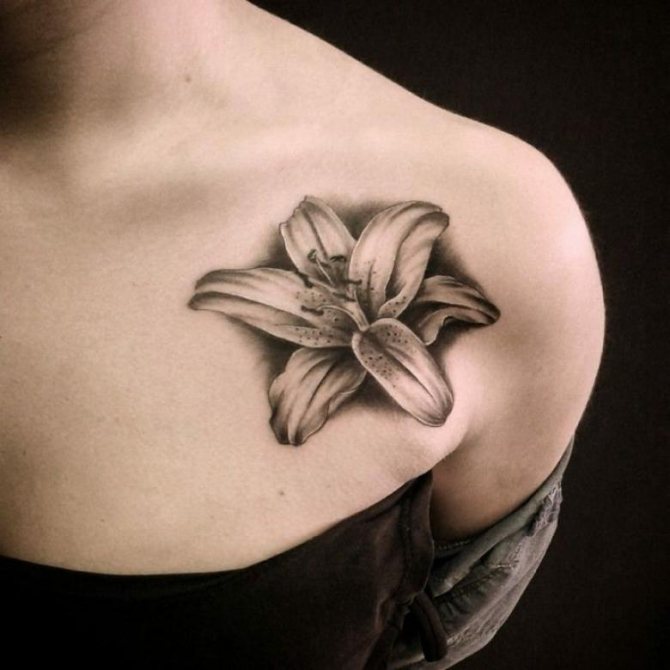

The owner of the tattoo with the image of a lily shows his desire to stand out among others. When choosing a sketch, the main factor is what meaning should be put into the tattoo. It can be reflected with the help of color design and features of the concept of the figure.
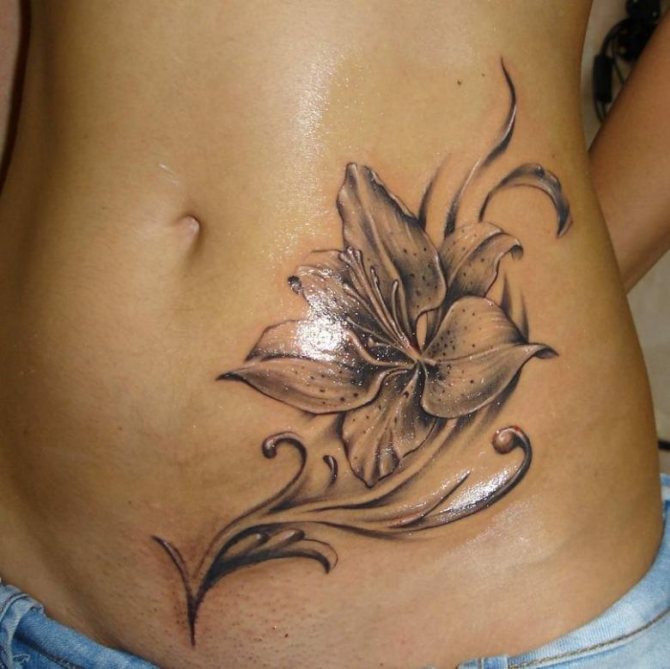

Whichever lily is chosen for the application, it is extremely important that the tattoo clearly reflects the credo of life and corresponds to the style and character of the person, even after many years.










